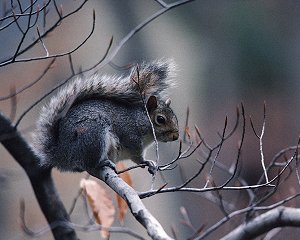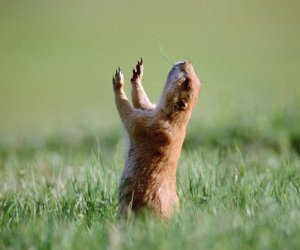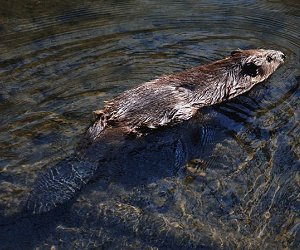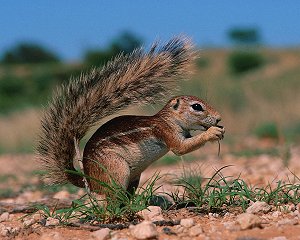THE ORDER RODENTIA
Rodentia – Gnawing Mammals (About 1700 species.)
Almost anywhere you look, except on the polar ice caps, you can find a rodent. Rodents are the most abundant land mammals, climbing or gliding among trees, darting across the ground, burrowing beneath the soil, or even swimming in lakes or streams. They are among the most beloved and the most detested of animals.

Although rodents first appeared on the scene during the Eocene epoch about 50,000,000 years ago, the family of Muridae rodents did not appear until about 5,000,000 years ago, and already comprise more than half of all species of rodents. They combine the three necessities to thrive on this planet: large litters quickly produced, ability to adapt quickly to environmental changes, and they are small animals that can easily hide from predators.
They consume all sorts of plant material, primarily seeds, but also stems, leaves, flowers, and roots, and insects, and other invertebrates. Some are partially carnivorous. Rodents number about 1700 species in 30 separate families. In short, they are a very successful order of mammals that has adapted to many different habitats.

Besides certain internal features, they have in common one conspicuous characteristic: a pair of long and prominent teeth (incisors), upper and lower. These chisel-like incisors, kept sharp through wear since there is hard enamel only on their front surface, are ever-growing and extremely effective for gnawing. The beaver’s industry in felling trees is the classic example, and is why the word “Rodentia” is used since it means “gnawing.”
All rodents have a large empty space in place of canine teeth to allow maneuverability with their incisors. Some species are provided with pouches or pockets either inside or outside their mouths, for carrying seeds or other food that they may gather. And it is habitual with many rodents to store food for future use.

Rodents range in size from that of mice and rats, the smallest being the Eurasian harvest mouse which weighs as little as 0.14 ounce, and the largest in the South American capybara weighing over 100 pounds. Their success as a group is no doubt due, at least in part, to their generally small size and high rate of reproduction. The survival of some species is further aided by the ability to hibernate in extreme cold or estivate in hot climates.
Perhaps because the order is so vast, rodents have developed certain specialized traits repeatedly in unrelated species. For example, North American kangaroo rats, Australian hopping mice, and north African jerboas, all in different families, do well in sandy desert regions and have evolved exceedingly long, narrow hind legs and feet with a correspondingly long tail used for hopping over the sandy expanses like miniature kangaroos. They all have keen hearing, small front limbs, similar pale coloration, and even the same hair tuft at the tip of the tail.

But rodents have been responsible for much damage. The rats carried the fleas that caused the plagues of Europe, and rats and mice spread other diseases as well. Their fondness for seed makes them a horrible pest for farmers and others who store grain during the winter. Beavers can cause destruction by damming up creeks causing water to back up into unwanted areas, and Prairie Dog burrows can bring down horses whose hooves fall into the holes and cause the horse to fall over. But because they tend to be so small and cute, they are often kept as pets – and so the love/hate relationship between humans and rodents continues.
Check out the following specific rodents included:
Mountain Beaver
Gray Squirrel
Fox Squirrel
Red Squirrel
Tassel-eared Squirrel
American Red Squirrel
Giant Squirrel
Tree Squirrel
Prevost’s Squirrel
Barbary Ground Squirrel
Geoffrey’s Ground Squirrel
Woodchuck
Marmot
Prairie Dog
Antelope Squirrel
13-lined Ground Squirrel
Arctic Ground Squirrel
California Ground Squirrel
Golden Ground Squirrel
Eastern Chipmunk
Least Chipmunk
Flying Squirrel
Pocket Gopher
Pocket Mouse
Kanagaroo Rat
American Beaver
Pel’s Flying Squirrel
Spring Hare
Rice Rat
Western Harvest Mouse
Deer Mouse
Grasshopper Mouse
Cotton Rat
Wood Rat
Golden Hamster
Common Hamster
Crested Rat
Collared Lemming
Norway Lemming
Bank Vole
Water Vole
Muskrat
Woodland Vole
Snow Vole
Gerbil
Jird
Mole Rat
Lesser Mole Rat
Harvest Mouse
Wood Mouse
Grass Rat
Rufous-nosed Rat
Black Rat
Brown Rat
Naked-tailed Rat
House Mouse
Hopping Mouse
Spiny Mouse
Pouched Rat
Climbing Mouse
Water Rat
Fat Dormouse
Common Dormouse
African Dormouse
Garden Dormouse
Jerboa
Crested Porcupine
American Porcupine
Prehensile Porcupine
Guinea Pig
Cavy
Capybara
Pacarana
Paca
Agouti
Plains Viscacha
Mountain Viscacha
Chinchilla
Hutia
Coypu
Tuco-tuco
Degu
Cane Rat
Sand Rat
